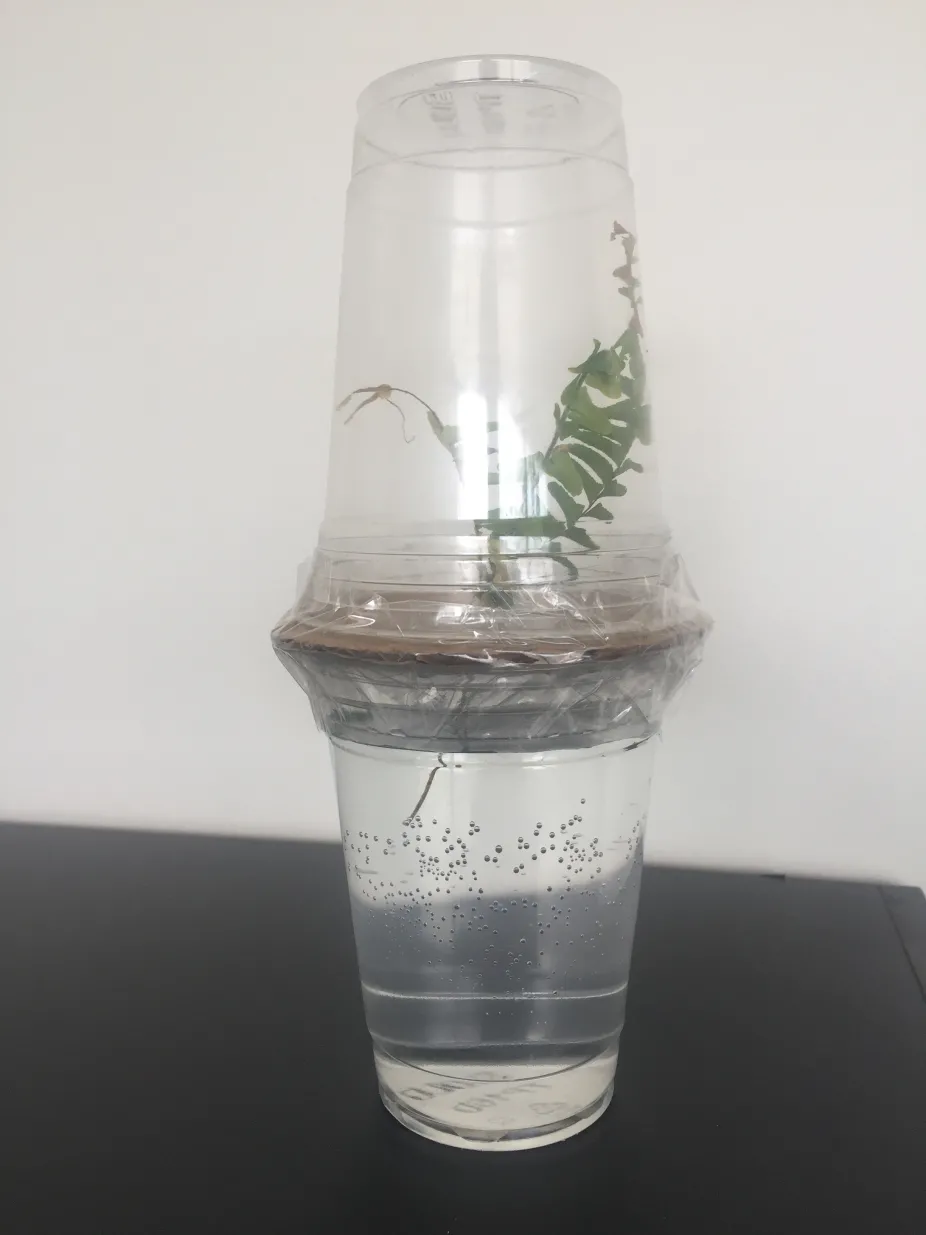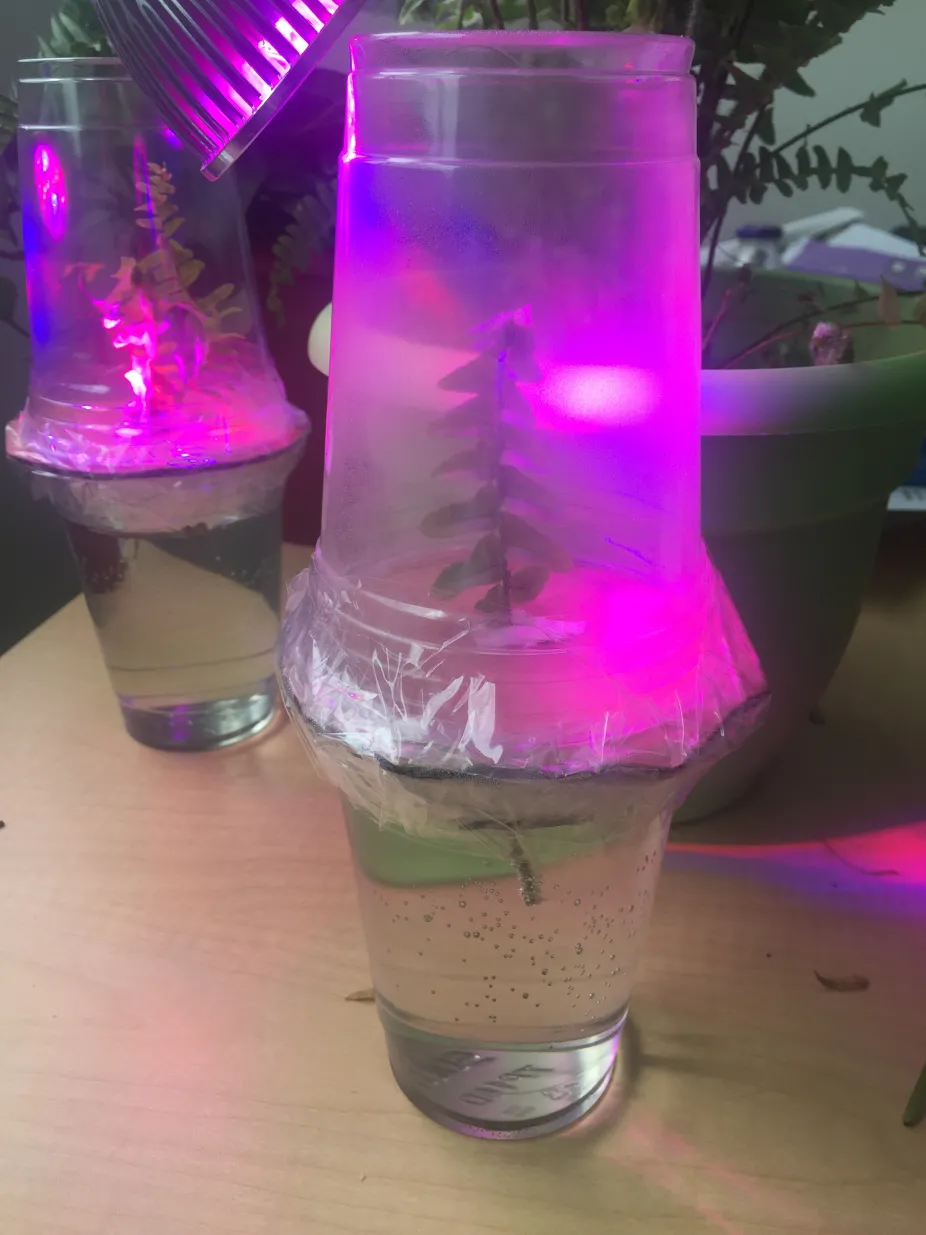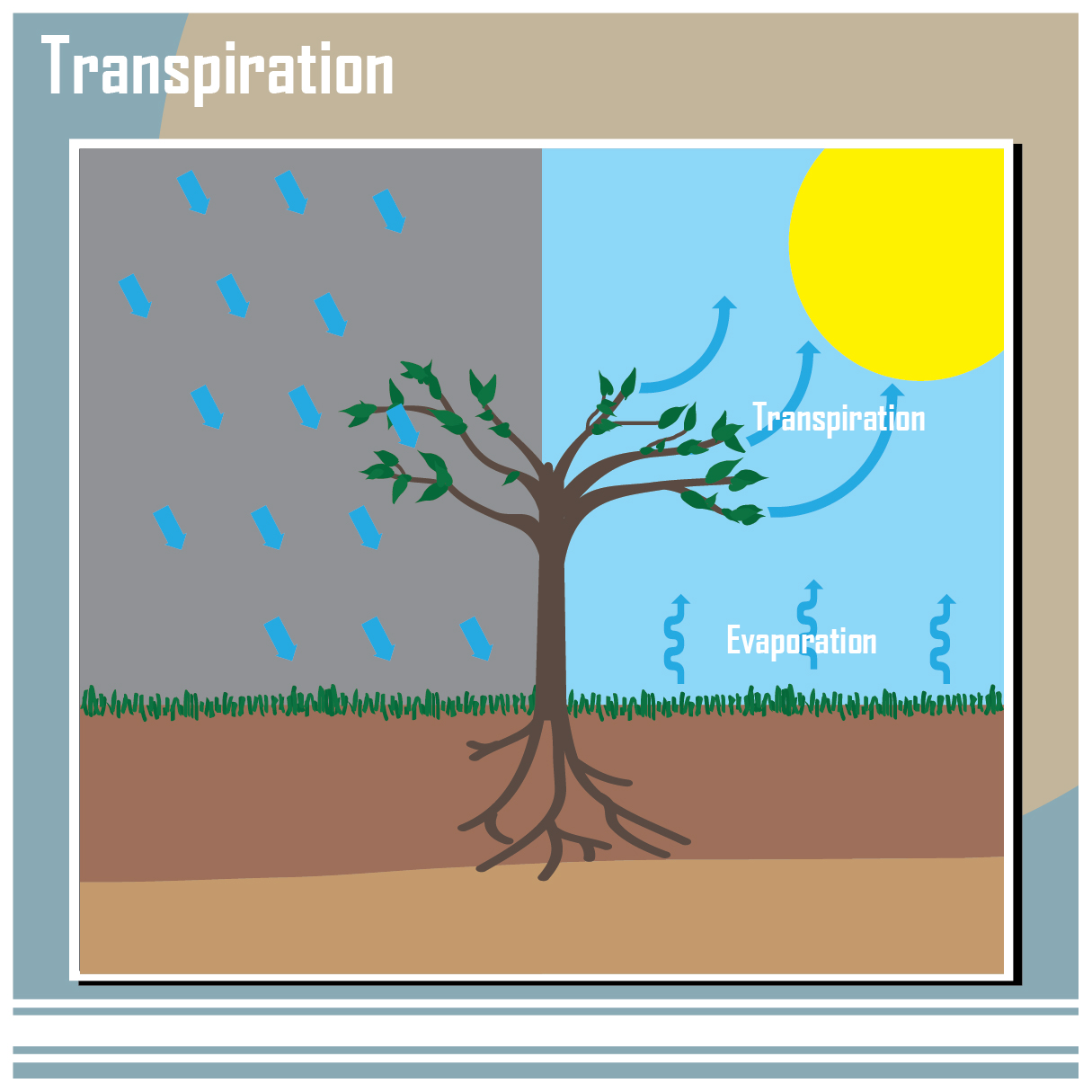Modeling Tree Transpiration
In this activity, students will observe and measure the water given off through transpiration by a plant in a small terrarium.
Learning Objectives
- Students will be able to recognize transpiration and explain its value to the plant.
- Students will be able to explain how transpiration affects climate.
Materials
For class demonstration or each team of 3-4 students:
- Two transparent plastic cups that are the same size and shape
- Cardboard
- A piece of a plant that thrives in a moist environment, such as a fern
- Mounting putty
- Wide, clear tape (such as packing tape)
- Grow light or window with sunlight
- Water
- Scissors
- Marker (optional)
Preparation
- Cut a small piece of plant for each student team. Use plants that typically grow in moist climates and are sensitive to drought stress (ferns, for example) because they tend to have a high transpiration rate.
- Cut a piece of cardboard for each student group that is the size of the cup openings (see directions for illustration).
Directions
- Introduce the activity
- Help students think about what they already know about plants. Ask students, why does a plant have roots? Students should recall that plant roots pull water out of the ground. Ask students to guess what happens to the water after it's pulled into the plant.
- If you are doing this activity as a part of unit in which students are learning about photosynthesis, then remind students that a plant needs water for photosynthesis and water is also a byproduct of photosynthesis. Ask students to consider where it goes.
- If you are doing this activity in the context of a unit about the water cycle, ask students to suggest where water goes in the water cycle after it is taken up by a plant.
- Tell students that in this experiment they will observe what happens to the water after a plant pulls it in through its roots. If the water is released by the plant's leaves, then water will move from the lower cup to the upper cup. Show students an example of the model they will make. Mention to students that this experiment uses materials to model sunshine (grow lamp) and a small part of a plant represents a tree.
- Help students think about what they already know about plants. Ask students, why does a plant have roots? Students should recall that plant roots pull water out of the ground. Ask students to guess what happens to the water after it's pulled into the plant.
-
Have students work in groups to make models using the instructions below.
- Using the scissors, make a small hole (just big enough for the plant stem) in the center of the piece of cardboard.
- Pull the plant stem through the hole and seal around the hole with mounting putty.
- Fill the bottom cup with water and place the stem with the cardboard collar into the cup. Cover with the clear plastic cup (as shown below).
- Place tape around the cardboard and the two cup openings to create a seal. Tell students that the tape should create a seal around the cardboard and the cup openings.

The setup for the transpiration experiment
UCAR
- At the end of the class period, have students put the small terrariums in the sunlight from a window or under a grow light. Have students discuss what they would expect to see in the upper cup if the plant is releasing moisture. Write the students' ideas on the board to consider during the next class period. Students will leave their terrariums until the next class.
- During the next class period, students should observe water droplets on the sides of the inverted cup. Have student groups write observations of where water is present.
- Have students consider what they expected to see (step 3) and what they observe. Ask students, where does the moisture come from that accumulates along the sides of the top cup? (The plant) And ask how we know the water is coming from the plant and not just evaporating from the water in the cup. (The lower cup was separated from the upper cup.)
- Explain that this process that allows plants to release moisture is called transpiration. Water vapor escapes from the plant through pores in the leaves called stomata (see background section for more detail). Discuss transpiration in the context of photosynthesis if this activity is used as part of plant biology instruction. Discuss transpiration in the context of the water cycle if this is a part of Earth science instruction.
(Note: The time it takes to see condensation depends on the strength of the sunlight or grow light, the transpiration rate of the plant, and how well the terrarium is sealed. Minimal condensation should occur within about 45-60 minutes but times can vary significantly based on source of sunlight, type of plant, and strength of the seal from the tape. More moisture will accumulate with time (See example below.)

Notice the condensation on the upper cup, which is evidence of transpiration. (The pink color is due to a grow light.)
UCAR
Extension Activities
Leave the terrarium cups set up in the classroom for several days and measure the amount of water transpired. To measure, mark the water level on the lower cup with a marker at the beginning of the experiment then draw another mark at the end of experiment. There should be a decrease in water which indicates the amount of water the plant transpired.
Do the extension above but give each student group different sizes of leaves or a different kind of plant. Compare the water levels between groups. Students should notice that some plants have higher transpiration rates (use more water from cup).
Assessment
- Ask students to draw pictures of how the water moved from the bottom of the cup to the top.
- Challenge students to imagine that their small plant was a large tree with a thousand times as many leaves. Have the students discuss how much water the tree would transpire compared to the small plant (more or less, and why?) Then ask students to imagine a forest with 1000 trees. Would more or less water transpire?
- Tell students that, just like human respiration, plants tend to transpire more with increased temperatures. Ask students, how will the water cycle be affected as climate warms?
Background
The Water Cycle
As it moves through the water cycle, water changes its state. At different times the same water can be a liquid, a solid (ice), and a gas (water vapor). Water at the surface of the ocean, rivers, and lakes can become water vapor and move into the atmosphere with a little added energy from the Sun through a process called evaporation.

While evaporation comes directly from the soil and bodies of water, transpiration involves the evaporation of water from plants. Evapotranspiration combines evaporation and transpiration. The Sun drives these processes. On rainy days with less sunlight, the rates of photosynthesis and evapotranspiration decrease.
Credit: US Army Corps of Engineers
Plants absorb water primarily through their roots. They release the water as water vapor into the atmosphere through openings in their leaves in a process called transpiration.Collectively, the water evaporated from the land and from plants is called evapotranspiration.
Photosynthesis
Photosynthesis is a chemical reaction in which the energy from the Sun is used to create sugar (glucose) for plants to grow. For the process of photosynthesis to occur, plants "breathe in" carbon dioxide (CO2) from the Earth's atmosphere (which humans and other animals breathe out).
When the stomata (similar to the pores of our skin) on the leaf of the plant open, the plant can photosynthesize but the plant also loses water through transpiration. As with human respiration, trees tend to transpire more with increased temperatures, more intense sunlight, higher water supply, and size. However, when it gets too hot, transpiration will shut down.
Transpiration Rates
Many factors influence transpiration rates, including leaf shape, size, pores (stomata), and waxiness of the leaf surfaces. Where a particular tree species grows often depends upon how it has adapted its transpiration rate to a particular climate. Conifer needles are more efficient at retaining moisture than broadleaf trees because they have stiff, waxy leaves (needles) with small stomata that are recessed in the leaf surface. Because they are efficient in retaining water, conifers are found in drier and colder climates where water supplies are limited.
Plants transpire vast quantities of water even though we cannot see it. Only one percent of all water a plant absorbs is used in photosynthesis; the rest is lost through transpiration. In one growing season, one corn plant transpires over 200 liters of water.
Climate Change Connection
Carbon dioxide (CO2) is a major greenhouse gas. The level of CO2 in the atmosphere has been increasing as we do things like burn fossil fuels and decrease the amount of forests. Carbon dioxide is contributing to the increase of the global average temperature and it can also have an impact on plant transpiration.
If CO2 levels in the atmosphere are high, the stomata on the leaves of the plant do not have to open as much to obtain the CO2 they need for photosynthesis. With the stomata less open, a plant will not be able to release as much water vapor through transpiration. The water vapor cools the plant and the air around it, so, on a global scale, as carbon dioxide levels climb, transpiration rates drop, which can cause even more climate warming.